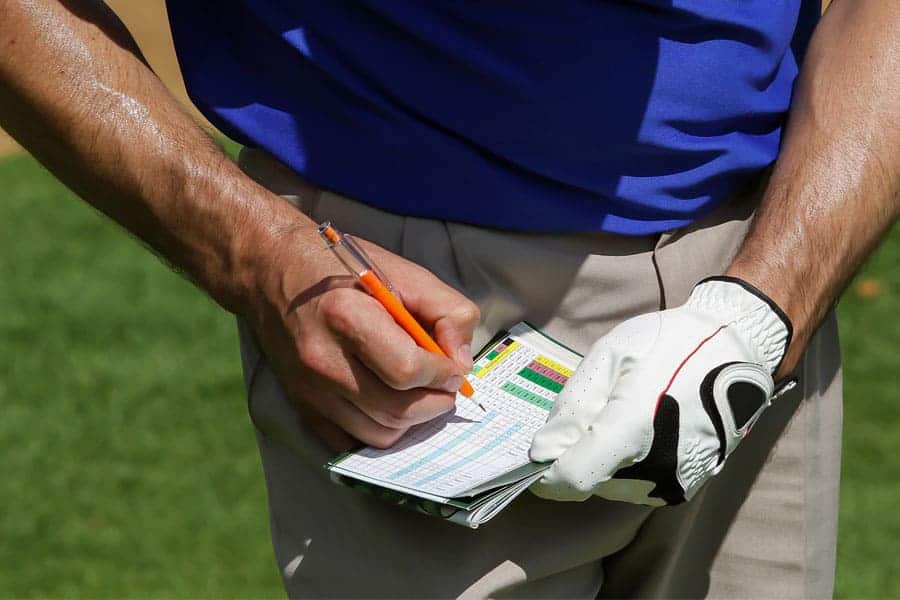Understanding Stableford Scoring System – Complete Overview

Stableford scoring system is used to give score points based on each hole. This article explains how it works and benefits golfers of all skill levels.
The two most basic forms of playing golf are match play and stroke play. But, other than these, have you ever heard about the Stableford scoring system?
What is the Stableford scoring system in golf?
The Stableford scoring system is a golf format that allows players to score points according to the number of strokes taken on each hole. This system has been around for over a century and is now commonly used by golfers of all levels.
Stableford points
Every hole’s point value is determined by comparing the number of strokes taken to a predetermined score which is usually a par. This fixed number then adjusts depending on each player’s handicap rating.
As mentioned earlier, the standard Stableford scoring points scored on each hole as per R&A, and the USGA are as follows:
| Points | Strokes taken in relation to an adjusted fixed score |
| 0 Points | Double Bogey or Worse (Two strokes or more over par) |
| 1 Point | Bogey (One stroke over par) |
| 2 Points | Par |
| 3 Points | Birdie (One stroke under par) |
| 4 Points | Eagle (Two strokes under par) |
| 5 Points | Albatross/Double Eagle (Three strokes under par) |
| 6 Points | Condor (Four strokes under par) |
Modified Stableford scoring format
As the name suggests, the Modified Stableford format is the modified version of the Stableford golf system. This method is employed once a year on the PGA Tour during the Barracuda Championship (formerly known as Reno-Tahoe Open). Unlike traditional scoring methods, where the aim is to have the lowest score, the goal in a Modified Stableford is to have the highest score.
The PGA Tour’s 2019 Barracuda Championship utilized the modified Stableford scoring with the following point allocations:
| Points | Strokes taken in relation to par |
| 8 points | Albatross (3-under-par) |
| 5 points | Eagle (2-under-par) |
| 2 Points | Birdie (1-under-par) |
| 0 points | Par (level) |
| -1 point | Bogey (1-over-par) |
| -3 points | Double Bogey or worse (2-over-par or more) |
History of Stableford scoring
In the late 1800s, Dr. Frank Barney Gorton Stableford (also sometimes known as the Patron Saint of Club Golfers) revolutionized golf by creating the revolutionary Stableford scoring system that kept players engaged even after bad starts to their rounds.
This ground-breaking format was first introduced for casual play at Glamorganshire Golf Club in Penarth, Wales. It was then utilized in tournament play at Wallasey Golf Club in England as early as 1932.
As a Glamorganshire and Wallasey Golf Clubs member, Stableford also belonged to Anglesey Golf Club North Wales for most of the 1920s.
The advantage that comes with playing Stableford is it enables players to speed up their pace as they don’t have to finish a hole if no points can be earned; instead, one can collect his/her ball and move on to the next hole.
This form of golf is especially loved in Great Britain since even after having an unlucky round, you still get competitive scores.
Stableford handicap stroke indexes
The stroke Index is the metric utilized to assign handicaps to holes. Any player with a Playing Handicap 18 will be granted an extra shot on every hole they play. This means that if the players make a gross bogey, it would equate to net par and would earn them two points for that particular hole.
A golfer with a Playing Handicap of 9 will receive shots on the Stroke Indexes from 1-9. Likewise, one with an index rating of 5 would be given strokes for holes ranging from 1-5.
If a golfer has a handicap of over 18, they will get multiple shots on some holes. For example, those with the Playing Handicap of 28 will receive two strokes at Stroke Indexes 1-10 and only one stroke for indexes 11-18.
Any golfer with a Playing Handicap of +3 must add extra shots onto their gross score for holes with stroke indexes between 16-18. That means in order to earn two points on these particular holes, the players must be able to attain at least one birdie during their round.
With the proper technique and skillful swing mechanics, even players with plus figures can make this happen.
Conclusion
The Stableford scoring system is an effective and fair way to play golf competitively. It encourages players to take risks and rewards them for doing so. At the same time, it takes the pressure off players who may not have the skills to shoot low scores by giving them points for playing well.
The Stableford system is based on holes-in-one, double bogeys, etc., and assigns points for each score. The player with the most points at the end of the round wins the game.
FAQs
What is a good score in Stableford?
Golfers should strive for a minimum of 36 points – 2 points per hole over 18 holes. However, as experienced players will attest, any score above the 32-point mark deserves admiration. Reaching 40 or more points signifies an extraordinary round!
What are the rules for the mixed golf team Stableford?
Golfers should strive for a minimum of 36 points – 2 points per hole over 18 holes. However, as experienced players will attest, any score above the 32-point mark deserves admiration. Reaching 40 or more points signifies an extraordinary round!
What happens if you play the wrong ball in Stableford?
If you have mistakenly used the wrong ball during a hole, make sure to add two strokes as a penalty. Continue playing with the same ball which was originally in use.








